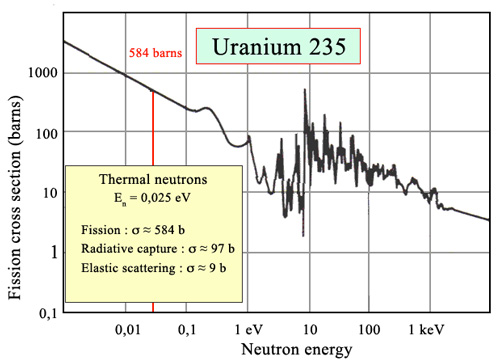Slow neutrons favour fission
In nuclear reactors slow neutrons are neutrons slowed down after a set of collisions on atomic nuclei. Their kinetic energy are of the order of a few electronvolts or a fraction of electronvolt (eV). When the neutron energy become comparable to the kinetic energies of the atoms belonging to the medium through which the travel, the neutron is said thermal
The adjective « slow » may be somewhat misleading. A 0,025 electronvolt thermal neutron travels at 2 km/sec, faster than the fastest airplane. But 2 km/sec is very slow compared to the speed of light. It is the kinetic energy that matters more than the speed of the neutron.

Fission probability of uranium-235
The fission probability – called fission cross-section by physicists – varies greatly with the neutron energy. It is measured in barns. For a fissile nucleus such as uranium-235, this fission probability is maximum for kinetic energies of a few electronvolts. Since the proportion of uranium-235 is only a few percents in most reactor fuels, it is necesseray to compensate for this low proportion by a large fission probalility of Uranium-235, therefore to operate with flux of a slow neutrons.
© IN2P3
Slow neutrons allow civilian nuclear reactors to operate with nuclear fuel containing natural uranium or uranium slightly enriched in fissile isotope 235. Without slow neutrons, the common pressurized (PWR) and boiling water (BWR) reactors would not operate. To achieve this, the neutrons emitted by nuclear fission have to be slowed down by collisions with the atoms of a medium called the moderator..
Natural uranium contains only 0,7% of fissile uranium 235. Reactors based on natural uranium fuel require performing moderators capturing very few neutrons : heavy water or pure graphite.
When the fuel is enriched, at the level of 3-4%, the moderator can be ordinary water which can be either boiling or subjected to great pressure (An efficient coolant, water is also a convenient medium to evacuate the heat from the core of the reactor).
Slow neutrons allow civilian nuclear reactors to operate with nuclear fuel, natural uranium or uranium slightly enriched in fissile isotope 235. The fission probability of an uranium-235 nucleus by a thermal neutron of 0.025 eV is 584 barns. This value is very large compared to the probability of capture – without fission – by a nucleus of the predominant uranium-238 isitope which is around 2 barns.
When captured, slow neutrons do not provide a significant surplus of energy to the nucleus. They are able to fission only a few very fragile nucley, dubbed for that reason fissile : uranium-235 (the only one found in Natural), plutonium-239 and uranium-233.
Slow neutrons have a highest fission probability (called cross-section) to be captured by a fissile nucleus then to trigger fission. The large fission cross-section compensates for the low proportion in the fuel. With a good moderator it is therefore possible to establish a chain reaction with natural or slightly uranium fuel (0.7% to 5% isotope 235).
Everything happens as if slow neutrons see the tiny minority of uranium-235 or plutonium-239 nuclei much more larger than the uranium-238 nuclei which forms the majority but have a much smaller probability of « sterile » capture without fission. It then becomes possible, with a good moderator, to get a chain reaction with poor or slightly enriched quoted above.
ALSO : Fast neutrons
ALSO : Neutron capture
Other articles on the subject « Neutronic Radiations »
Neutron Capture
Capture competes with fission and generates radioactivity The neutron is a special elementary par[...]
Neutron Balance (fission)
What happens to fission neutrons? Within a reactor the objective is to maintain the chain reactio[...]
Slow and fast neutrons
Fission depends on the energy of the neutrons Nuclear fission can occur when a nucleus is rendere[...]
Fast neutrons
Fast neutrons for surgeneration and breeders Before they are slowed down by a large number of nuc[...]
Neutron Moderators
Slowing fast neutrons without capturing them The presence of a moderator; is essential for operat[...]